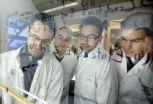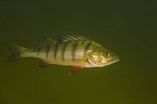(Press-News.org) UNIVERSITY PARK, PA. -- Researchers have studied viruses as agents of disease in humans, domestic animals and plants, but a study of plant viruses in the wild may point to a more cooperative, benevolent role of the microbe, according to a Penn State virologist.
"Most of these wild plants have viruses," said Marilyn Roossinck, professor of plant pathology and environmental microbiology and biology, who has examined more than 7,000 individual plants for viruses. "But they don't have any of the symptoms that we usually see in crop plants with viruses."
Most of the viruses Roossinck studied are new viruses, although they are related to viruses that have been examined in crops. According to the researcher, about half of the viruses that infect wild plants tend to be continually present in the plant -- persistent.
The viruses get passed from plants to their offspring through the seeds. Researchers are still trying to uncover exactly what viruses are doing in the plants. Since the viruses are found so often, they may be playing some role in the life of the plant, according to Roossinck.
In fact, studies indicate that viruses can be beneficial to some plants, making them hardier and helping them survive extreme temperatures and drought, said Roossinck, who reported on her research today (Feb. 17) at the annual meeting of the American Association for the Advancement of Science.
"When most people think of viruses, they think of serious diseases and death, such as the AIDS virus," Roossinck said.
However, on a research trip in Costa Rica, a biodiversity hot spot in Central America, she noticed that unmanaged wild plants looked healthier than managed agricultural fields.
During her research, Roossinck observed that most of the approximately 10,000 species of wild plants at the study site appeared healthy. The wild plants she studied included Fabaceae, an abundant family of plants related to beans. However, commercial crops -- melons, oranges, pineapple and aloe -- that were growing near the site were not as healthy.
"When I went to the forest, the wild plants looked healthy and gorgeous," Roossinck said. "Then, I went 10 kilometers away and the plants in the agricultural field were not looking so healthy. In the forest the plants are full of microbes: viruses, fungi and bacteria, whereas in crops farmers try to eliminate the microbes. Perhaps there is a connection."
Indeed, one plant virus that was found frequently in the forest was also found in nearby melon crops. In the melons it was causing severe disease, while in the wild plants there were no symptoms. Analyzing the viruses suggested that they were moving from the crops into the wild plants, but somehow the wild plants remained healthy.
Roossinck said she is curious about how the wild plants avoid disease, and if there is a way this can be used in agriculture.
###**mls**
Highlights
A technique that removes additional toxins during dialysis decreased kidney failure patients' risk of dying from any cause by 30% over three years.
The technique also reduced patients' risk of dying from heart-related causes or infections.
15% to 25% of dialysis patients die annually.
Washington, DC (February 14, 2013) — A technique that removes additional toxins during dialysis may prolong kidney failure patients' lives, according to a clinical trial appearing in an upcoming issue of the Journal of the American Society Nephrology (JASN). In light of ...
We are constantly being bombarded by speedy, energetic, and yet unassuming, particles called cosmic rays. These charged particles (mostly protons), continuously assail the Earth from outer space. There is general consensus among scientists that supernova remnants (the leftovers of a supernova explosion) are the sources of cosmic rays, but the final proof has been elusive since cosmic rays are deflected on their way from the source to Earth.
A new study offers conclusive evidence that cosmic ray protons within our galaxy are accelerated in the shock waves produced by ...
Anxiety-moderating drugs that reach waterways via wastewater create fearless and asocial fish that eat more quickly than normal. These behavioral changes can have serious ecological consequences. This is shown by Umeå University researchers in the prestigious journal Science.
Many drugs leave our bodies unaffected, and residues from them are therefore found in wastewater. Low concentrations of drugs are often found downstream from sewage treatment plants. Today we test how dangerous drugs are to humans, but our knowledge of the environmental impacts of drugs is limited. ...
Pharmaceutical drugs that end up in the world's waterways after being excreted, flushed and treated at wastewater treatment plants may lead to unexpected ecological impacts, according to a new study of wild European perch. Tomas Brodin and colleagues from Umeå University in Sweden discovered that the fish ate faster, became bolder and acted less social after being subjected to an anxiety-moderating drug, known as Oxazepam.
The psychiatric drug is used to treat anxiety in humans. But, Oxazepam residues often wind up in natural aquatic systems, downstream from sewage treatment ...
Menlo Park, Calif. — A new study confirms what scientists have long suspected: Cosmic rays – energetic particles that pelt Earth from all directions – are born in the violent aftermath of supernovas, exploding stars throughout the galaxy.
A research team led by scientists at the Kavli Institute for Particle Astrophysics and Cosmology at the Department of Energy's (DOE) SLAC National Accelerator Laboratory sifted through four years of data from NASA's Fermi Gamma-ray Space Telescope to find the first unambiguous evidence of how cosmic rays are born.
Reporting in the ...
This press release is available in German.
Bremerhaven, 14 February 2013. Huge quantities of algae are growing on the underside of sea ice in the Central Arctic: in 2012 the ice algae Melosira arctica was responsible for almost half the primary production in this area. When the ice melts, as was the case during the ice minimum in 2012, these algae sink rapidly to the bottom of the sea at a depth of several thousands of metres. Deep sea animals such as sea cucumbers and brittle stars feed on the algae, and bacteria metabolise what's left, consuming the oxygen in the ...
DARIEN, IL – A new study confirms a link between insomnia and thoughts of suicide and suggests that this relationship is mediated by dysfunctional beliefs and attitudes about sleep as well as nightmares. The study suggests that the targeted assessment and treatment of specific sleep problems may reduce the risk of suicide in people with depressive symptoms.
"Insomnia and nightmares, which are often confused and go hand-in-hand, are known risk factors for suicide but just how they contribute was unknown," said Dr. W. Vaughn McCall, the study's lead author and chair of ...
BOSTON – The trolls are winning.
Pick a story about some aspect of science, any story, scroll down to the blog comments and let the bashing begin:
"Wonder how much taxpayer cash went into this 'deep' study?"
"I think you can take all these studies by pointy headed scientists, 99 percent of whom are socialists and communists, and stick them where the sun don't shine."
"Yawn. Climate change myth wackos at it again."
"This article is 100 percent propaganda crapola."
"Speaking of dolts, if you were around in the 70s, when they also had scientists, the big talk ...
Even in the presence of screening, there is benefit to radical prostatectomy (RP) in prostate cancer patients, however, the benefit is limited to a subgroup of patients and can take years to become evident according to a study published February 14 in the Journal of the National Cancer Institute.
The Scandinavian Prostate Cancer Group Study Number 4 (SPCG-4) trial identified that RP lowered prostate cancer deaths with a statistically significant absolute mortality difference (AMD) between RP and watchful waiting (WW) of 6.1%. The Prostate Cancer Intervention Versus Observation ...
FINANCIAL DISCLOSURE: CJ was funded by a grant from the Agence Nationale de la Recherche (projet n_ BLAN06-3_141806). The funders had no role in study design, data collection and analysis, decision to publish, or preparation of the manuscript.
COMPETING INTEREST: The authors have declared that no competing interests exist.
PLEASE ADD THIS LINK TO THE PUBLISHED ARTICLE IN ONLINE VERSIONS OF YOUR REPORT:
http://dx.plos.org/10.1371/journal.ppat.1003178
(link will go live upon embargo lift)
CITATION: Johnston C, Martin B, Granadel C, Polard P, Claverys J-P (2013) Programmed ...


